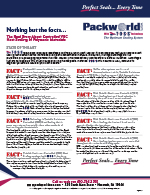The Real Story about Controlled Impulse Heat Sealing of Polymeric Materials
Nothing but the facts...
State of the Art – TOSS® Technology...
is Variable Resistance Controlled (VRC) Heat Sealing: It is an improved method of impulse heat sealing that overcomes the limitations of simplistic conventional methods. In addition, it brings advantages to the fabrication and packaging requirements found in the Medical / Pharmaceutical / Healthcare and Biotech Industries. Advantages not available with other modes of joining thermoplastic materials. Along with PackworldUSA, they combine to engineer Validatable Medical Impulse Heat Sealers.
 PackworldUSA exclusively uses TOSS Technology - The Optimum Sealing System in their entire line of Validatable Medical Impulse Heat Sealers.
PackworldUSA exclusively uses TOSS Technology - The Optimum Sealing System in their entire line of Validatable Medical Impulse Heat Sealers.
Dedicated to providing superior quality, value, and performance, PackworldUSA employs state of the art technology in all aspects of its machine designs. TOSS Technology has been tested and selected because it produces a high response, accurate temperature control for both heating and cooling that is more precise than any other system.
 PackworldUSA focuses its efforts in providing premium heat sealing equipment to the Medical / Pharmaceutical / Healthcare and Biotech Industries.
PackworldUSA focuses its efforts in providing premium heat sealing equipment to the Medical / Pharmaceutical / Healthcare and Biotech Industries.
With its single focus on Precision, Validatable Impulse Heat Sealers, it’s no wonder that PackworldUSA’s customer list reads like a Who’s – Who of Fortune 500 companies engaged in all aspects of the medical industry. Not trying to be all things to all markets allows Packworld to allocate its resources towards understanding and meeting the ever changing demands of the medical market.
 TOSS Technology is Variable Resistance Controlled (VRC) Heat Sealing that is more accurate and repeatable than other methods of heat sealing plastic materials.
TOSS Technology is Variable Resistance Controlled (VRC) Heat Sealing that is more accurate and repeatable than other methods of heat sealing plastic materials.
The heatseal band temperature is controlled with instant feedback because the controller constantly monitors the change in resistance of the heatseal band and compensates based upon Ohm’s Law. The electrical resistance of the heatseal band is directly proportional to the band temperature. With VRC the actual band temperature is immune from external thermal influences and the controller responds instantly (every 16 milliseconds) based solely on the precise feedback signal from the heat seal band.
 Variable Resistance Controlled (VRC) Heat Sealing employed with TOSS Technology has built in system monitoring that detects errors in the system.
Variable Resistance Controlled (VRC) Heat Sealing employed with TOSS Technology has built in system monitoring that detects errors in the system.
The system monitors each and every heat seal cycle to determine if the sealing parameters conform to the established protocol. Failure to conform will shut down the system and provide an error message that describes the fault.
 Unlike other systems used to seal thermoplastic materials, Variable Resistance Controlled (VRC) Heat Sealing can seal ALL thermoplastics.
Unlike other systems used to seal thermoplastic materials, Variable Resistance Controlled (VRC) Heat Sealing can seal ALL thermoplastics.
Some thermoplastic materials cannot be sealed at all without a cooling phase while others become brittle if cooled to rapidly. Constant heat sealing may provide an acceptable seal on certain materials but VRC heat sealing is suitable for ALL heat sealing applications.
 With Variable Resistance Controlled (VRC) Heat Sealing heat seal bandselection is critical in obtaining the perfect seal or cut and seal.
With Variable Resistance Controlled (VRC) Heat Sealing heat seal bandselection is critical in obtaining the perfect seal or cut and seal.
The selection of the ideal cross-section of the heat seal band can make the difference between perfection and mediocrity. The heat seal band must have sufficient mass to store the heat energy required for delivery to the material being sealed. With TOSS Technology, heat seal bands are available in more than 300 shapes and sizes.
 With Variable Resistance Controlled (VRC) Heat Sealing,the heatseal band can be energized before the jaw closes.
With Variable Resistance Controlled (VRC) Heat Sealing,the heatseal band can be energized before the jaw closes.
This saves time because the heat seal band can reach sealing temperature before it makes contact with the work piece. The controller prevents temperature overshoot while the jaw is closing.
 With Variable Resistance Controlled (VRC) Heat Sealing, jaw barpressure is controlled throughout the entire heat sealing cycle.
With Variable Resistance Controlled (VRC) Heat Sealing, jaw barpressure is controlled throughout the entire heat sealing cycle.
VRC employs heat and pressure to force the materials together at temperatures that induce co-mingling of the polymer structures. Only by controlling the pressure through the cooling cycle can one be assured of achieving the optimum seal.

